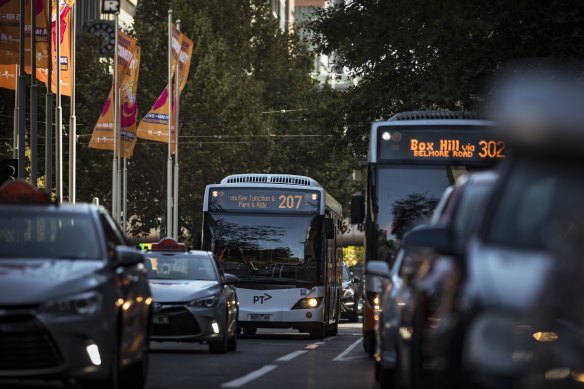
Melbourne’s bus system needs significant reform to meet the city’s growing transport demands, according to the state infrastructure adviser, which says Victoria gets poor value from the $800 million it spends running the network every year.
Infrastructure Victoria also warns in a new report that bad bus services are entrenching disadvantage in Melbourne’s outer suburbs, where people with the greatest need for affordable transport do not get it.
The bus network is not delivering value for money, Infrastructure Australia says.Credit:Chris Hopkins
“We have an enormous opportunity to make more of Melbourne’s 400-plus bus routes,” said Johnathan Spear, the independent government adviser’s chief executive. “With the right route design, cheaper fares and more frequent services, buses can deliver safe, affordable public transport where it is needed most.”
A discussion paper on bus reform, which Infrastructure Victoria will release on Monday, identifies a politically risky redesign of the network as one potential solution. It would sacrifice network coverage and many of the bus stops dotted around suburbs in favour of more frequent, direct and faster routes.
Reforming Melbourne’s bus network is being discussed by the state government after many years of decline. The Andrews government released a bus strategy last year that identified the need to grow patronage and improve service, with work now under way to determine how to achieve that over the next eight years.
Public Transport Minister Ben Carroll said the government was “deeply invested in supporting and upgrading Victoria’s bus network”, through its reform plan, new school buses and an electric bus trial.
“Since 2014, we have invested more than $500 million in successive budgets in new and improved bus services, with hundreds of new or upgraded routes added to the network,” he said.
Buses receive 30 per cent of public transport funding in Melbourne but provide only 20 per cent of the trips. Infrastructure Victoria’s paper finds the $800 million of annual funding could be better spent, with almost half of Melbourne’s 400 bus routes picking up fewer than 20 passengers an hour.
The paper says Melburnians rarely considered buses as an alternative to driving their cars because buses are infrequent, slow and follow complicated routes. Service is unreliable and confusing, with users often unable to access real-time information about when their bus will arrive.
The lack of better bus services pushed families in outer suburbs into costly car ownership, which often entrenched economic disadvantage, the paper says. Others disadvantaged Victorians simply cannot afford to travel where they need to go.
Eighty-two per cent of homes in Melbourne are within a five-minute walk of a bus stop, but that wide network coverage means buses follow long, winding routes through suburban streets. Many parts of Melbourne’s outer and growth-area suburbs have waiting times longer than 30 minutes between buses, sometimes exceeding an hour.
The Infrastructure Victoria paper says it may be better to reduce network coverage in favour of running faster, more frequently and on direct routes that attract more riders.
A bus route in Clyde North, in the city’s outer south-east, which followed this strategy attracted patronage about 40 per cent higher than conventional routes in similar areas, with residents willing to walk further – up to a kilometre – to access the better service.
Spear said buses could be a “compelling alternative” to driving and attract new users if they were more frequent, ran longer through the day and weekend, and went directly between activity centres.
On-demand services, such as the FlexiRide buses that operate in some outer suburbs, could provide essential transport in areas with low patronage, the report says.
Melbourne University transport planning lecturer John Stone said the “bold” reform the bus system badly needed would necessitate cutting some routes and stops in favour of an overall more effective network.
“The biggest obstacle is … for the government to focus on the benefit that gives to the wider community and to not get caught up in what has in the past become a political battle about what happens to a particular bus on a particular street,” Stone said.
Infrastructure Victoria will publish a final report in late 2023 that will include its recommendations for bus reform.
The Morning Edition newsletter is our guide to the day’s most important and interesting stories, analysis and insights. Sign up here.
Most Viewed in National
From our partners
Source: Read Full Article
